Badgers or Grizzlies? Cyclone or Huskies?
If the NCAA Tournament were a fight to the death between mascots, who would win?
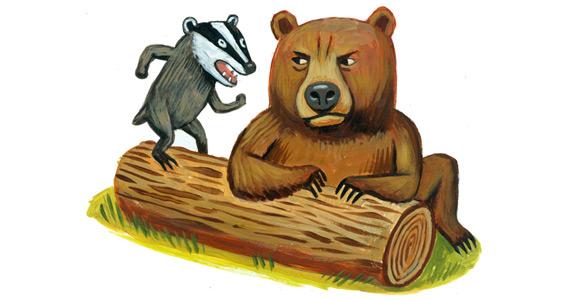
Illustration by Charlie Powell.
Also in Slate, Chris Wilson explains how to win your NCAA pool. Plus, you can download Holly Allen’s printable 2012 school color and mascot brackets.
On Thursday afternoon, the Wisconsin Badgers point guard Jordan Taylor will square off with the Montana Grizzlies, who are led by high-scoring guard Will Cherry. But what if, instead of this pedestrian display of human athletes on the basketball court, we got to see a pack of fearless, stocky badgers tear into a bunch of voracious 600-pound grizzly bears? Now that’s a No. 4 vs. No. 13 matchup that I’d tune in for.
We’ve put the madness back into March Madness by creating a parallel tournament of hypothetical showdowns between real-life incarnations of the teams’ nicknames. In each of the blurbs below, we’ve given our take on what would happen if, say, a group of blue devils ran across some mountain hawks in a dark alley. But since we’re not omniscient, we’ve also included a series of polls, allowing you to make your own picks. Check back on Friday to see which teams advanced and vote on the next round. The results of the real NCAA tournament will have no bearing on this competition. We’ll crown our own Final Four of nicknames and declare the ultimate NCAA mascot-fight champion.
A few explanatory ground rules:
1) These fights are based on the teams’ nicknames, not their mascots per se. For our purposes, the buckeyes are a team of nuts an inch in diameter—not a bunch of Brutuses. Where a team’s nickname is ambiguous—as with the Mississippi State Delta Devils or the Murray State Racers—the school’s logo or mascot can, however, inform us as to the identity of the nickname’s referent.
2) A team can win by devouring, dismembering, killing, incapacitating, or otherwise subduing its opponent—but not by just evading it indefinitely. A blackbird may be able to wear down its foe by flitting just out of reach, Muhammad Ali-style, but eventually it has to make a stand if it wants to advance. An exception is made when your opponent is a weather system. If you merely survive a cyclone, then that is considered sufficient for victory.
3) Unless otherwise indicated, the games are five-on-five. Notable exceptions include collective nouns—a wolfpack, as in the case of North Carolina State, typically consists of roughly eight wolves—and forces of nature, which are assumed to travel solo.
4) The matchups take place in a basketball gym. This gives the competition a fighting chance against gators, who would hold an unfair advantage in the water, and musketeers, whose long-range marksmanship would render them unstoppable on a battlefield.
Now, let’s get on with the action.
South Region
No. 1 Kentucky Wildcats vs. No. 16 Mississippi Valley State Delta Devils
The Delta Devils may have blown a huge lead in Tuesday night’s play-in game against the Western Kentucky Hilltoppers, but we don’t care about on-court results in this tournament. Though intelligence on the delta devils is scant, the team’s logo depicts a pointy-faced orange man in a green cape who can produce flames from his bare hands. It’s hard to see some hilltoppers—near as we can reckon, people who live on hills—standing up to that sort of barrage. Having torched the Hilltoppers, these mysterious Southern demons will have little trouble with Kentucky’s felines. In real life, it must be said, these “wildcats” don’t actually look that ferocious.
No. 8 Iowa State Cyclones vs. No. 9 Connecticut Huskies
Few mortal creatures can match up with a 60-mile-wide force of nature that lays waste to entire cities. Yet cyclones are maddeningly inconsistent, producing tidal floods and gale-force winds one day and petering into a drizzle the next. And if anyone can withstand the blow, it’s a team of huskies—swift, hardy dogs bred to pull sleds halfway across Alaska in a blizzard. This is just the worst possible first-round draw for the cyclones—a really tough break for a phenomenon that could’ve made it to the Final Four.
No. 5 Wichita State Shockers vs. No. 12 Virginia Commonwealth Rams
Shockers, so named because Wichita State players used to offset their tuition bills by “shocking” wheat, are Midwestern farm boys. (The team’s mascot, on the other hand, is a scowling, human-size shock of wheat.) They may be on the doughy side, but they’re resourceful. And while Dodge truck ads have done an admirable job imbuing rams with an aura of potency, let’s face it: They’re male sheep. This round goes to humankind.
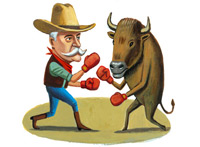
Illustration by Charlie Powell.
No. 4 Indiana Hoosiers vs. No. 13 New Mexico State Aggies
A Hoosier is an inhabitant of Indiana. An aggie is someone engaged in the agricultural trades, or perhaps a student aspiring to be so engaged. Lacking sufficient grounds to make a judgment, we turn to the Aggies’ logo, which is armed with a pair of six-shooters. Those guns should ensure that Indiana leaves this matchup with five fewer inhabitants.
No. 6 UNLV Runnin’ Rebels vs. No. 11 Colorado Buffaloes
In this corner, we have a one-ton beast with 2-foot-long horns. And over here we have a Yosemite Sam-like character who looks old enough to have fought for the Confederacy. You can run, Reb, but you can’t run fast enough.
No. 3 Baylor Bears vs. No. 14 South Dakota State Jackrabbits
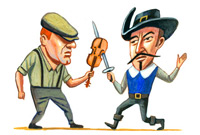
Illustration by Charlie Powell.
Jackrabbits are elusive, and they’ll try to exhaust the bears by hopping all over the gym. The bunnies, though, will eventually have to confront their much larger and fiercer antagonists. When they do, it won’t go well.
No. 7 Notre Dame Fighting Irish vs. No. 10 Xavier Musketeers
At close range, Irish pugilists can be dangerous, raining down blows and incomprehensible curses. But Athos, Porthos, and Co. are not about to be lured into a barroom brawl. Versatile and well-armed, they’ll make quick work of the lads from the Emerald Isle.
No. 2 Duke Blue Devils vs. No. 15 Lehigh Mountain Hawks
By the nicknames-not-mascots rule, the Blue Devils are not goateed men in blue masks, but members of the French Army’s mountain infantry unit, nicknamed les diables bleus. According to Duke’s university archives, they also wore flowing capes and jaunty berets. If Lehigh were still the Engineers—as they were until an ill-advised 1995 name change—they might just be clever enough to prevail, perhaps by rigging the stadium scoreboard to fall on their heavily armed foes. But while a mountain hawk is an adroit hunter in its native environment, it’s the hunted here.
West Region
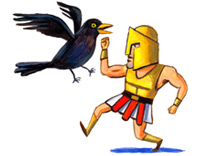
Illustration by Charlie Powell.
No. 1 Michigan State Spartans vs. No. 16 LIU-Brooklyn Blackbirds
It’s conceivable that a less-disciplined band of ancient fighters could be frustrated by the blackbirds’ small size and aerial agility. Spartan hoplites, however, were among history’s best-trained combatants, raised from birth to be killing machines and prohibited from any trade but war. They’ll spear the blackbirds and eat them for a snack.
No. 8 Memphis Tigers vs. No. 9 St. Louis Billikens
The billikens, elfin charm dolls with pointy ears created by a St. Louis schoolteacher in 1908, are a delightful anomaly in the macho world of sports mascots. The tigers will eat them.
No. 5 New Mexico Lobos vs. No. 12 Long Beach State 49ers
Participants in California’s gold rush of 1849 were a rowdy and lawless bunch, but pans and pickaxes won’t be enough to beat back a pack of hungry wolves. The 49ers also won’t be able to buy their way out of this one, as gold is less valuable to the lobos than delicious prospector flesh.
No. 4 Louisville Cardinals vs. No. 13 Davidson Wildcats
The cats couldn’t believe their good fortune when this tournament draw was announced.
No. 6 Murray State Racers vs. No. 11 Colorado State Rams
The Kentucky-based Racers’ logo indicates that they’re jockeys on horseback, or perhaps—casting aside anthropocentrism—thoroughbreds burdened with jockeys. This is a tough one to call, as both contestants are sturdy but neither possesses intimidating weaponry. Yes, rams have horns, but they have a tendency to curve in the wrong direction. This YouTube video gives a sense of just how boring a horse vs. ram standoff could be. Assuming the horses’ dainty riders can dismount, however, they could probably wrestle the rams into submission.
No. 3 Marquette Golden Eagles vs. No. 14 BYU Cougars
Golden eagles are no yardbirds. With a 6-foot wingspan and powerful talons, they’re capable of snatching up small cats and even mountain goats. Unfortunately for these birds of prey, cougars are not small cats; adult males grow upward of 7 feet long. After lunching on a merry band of Gaels in the play-in round, they’ll track down and eviscerate the eagles for dessert.
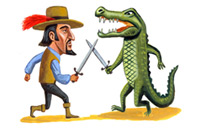
Illustration by Charlie Powell.
No. 7 Florida Gators vs. No. 10 Virginia Cavaliers
One of the first round’s marquee matchups pits skilled 17th-century swordsmen loyal to King Charles I against the swamp’s apex predators. Gators are usually shy around people, but when they do attack, it’s with surprising speed: Despite growing 12 feet long and weighing up to 800 pounds, American alligators can move as fast as humans over short distances. Cavaliers are at their best on horseback, but their mounts will surely bolt from this confrontation. Once on foot, the cavaliers will need all of their fencing skills to parry the gators’ lunges. And imagine their disconcertment when they land their first clear thrust, only to find it repelled by the reptiles’ tough, armor-plated skin. Stabbing at the animals’ mouths may seem a wise alternative, but alligators bite with a force that has been measured at 2,125 pounds—the weight of a small truck. The gators won’t come away unscathed, but when it’s over, the Kings of the Everglades will have the king’s loyalists in their bellies.
No. 2 Missouri Tigers vs. No. 15 Norfolk State Spartans
Another elite matchup. If the entire Spartan Army could join the fray, they could rely on their superior organization and tactics to corral, confuse, and spear the tigers. Over the centuries, humans have reputedly killed tigers by blinding them with birdlime, booby-trapping bamboo bridges, or setting fires to drive them into nets. But all of these strategies take more time and preparation than a TV timeout. In an impromptu five-on-five battle, even the staunchest ancient soldiers are no match for the world’s largest predatory cats, which stretch 11 feet from head to tail, weigh 600 pounds, and have three-inch-long canine teeth. This is a case where horses or guns would have really come in handy.
East Region
No. 1 Syracuse Orange vs. No. 16 UNC-Asheville Bulldogs
Another team undone by a nickname change. A band of Orangemen—Syracuse’s nickname until 2004—would have been heavily favored here, but a color, lacking three-dimensionality, is unlikely to pose much of a threat. The only exception we can think of would be a matchup between bulls and crimson.
No. 8 Kansas State Wildcats vs. No. 9 Southern Mississippi Golden Eagles
A classic 8-9 pairing, with the competitors so evenly matched that a standoff seems inevitable. Golden eagles routinely prey on foxes and small cats, while many wildcats’ diets include small- to medium-size birds. Either could prevail, given the element of surprise. We’ll take the vigilant raptors to win in overtime while the wildcats are napping.
No. 5 Vanderbilt Commodores vs. No. 12 Harvard Crimson
Again with the colors. Vanderbilt’s namesake, the shipping magnate Cornelius Vanderbilt, wasn’t actually a naval commander—“Commodore” was a nickname, and he was known for piling up wealth, not enemy bodies. In this matchup, however, military prowess is not required.
No. 4 Wisconsin Badgers vs. No. 13 Montana Grizzlies
Once a sneaky sleeper pick, like Gonzaga, badgers—in particular the honey variety—have burst into the mainstream consciousness of late, and their tenacity is no longer a secret. While they may be nasty and fearless, the badgers would be better-served by caution in this matchup. Grizzlies might seem peaceful, even gentle, but getting too close to them is not a good idea.
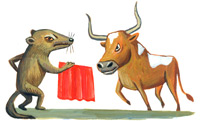
Illustration by Charlie Powell.
No. 6 Cincinnati Bearcats vs. No. 11 Texas Longhorns
Befitting a team from Texas, the longhorns have a huge size advantage, and unlike the rams, their horns are built to impale. Bearcats, also known as binturongs, have a bearish gait and body shape, but their face—and more importantly, their size—is closer to that of a cat. One of only two carnivores with a prehensile tail, they’re agile tree climbers, so they might elude the bulls for a time by scaling the hoop or the rafters. Territorial, they warn off predators by emitting a popcorn-scented musk, and they can be vicious when cornered. In an up-tempo contest, they’d be a tough out, but these ankle-biters just aren’t built to take down 1,000-pound cattle.
No. 3 Florida State Seminoles vs. No. 14 St. Bonaventure Bonnies
What’s a Bonnie? The logo depicts a wolf, but according to this promotional video, it’s actually a St. Bonaventure student: a Christian who is mentally disciplined, and who “thinks they’re extraordinary” and “going to go places.” Those hopes and dreams are going to get crushed against the Seminoles, whose warriors used guerrilla tactics to confound better-armed militia and U.S. Army forces for eight years in the 19th century’s Second Seminole War.
No. 7 Gonzaga Bulldogs vs. No. 10 West Virginia Mountaineers
Bred for the medieval sport of bull-baiting, in which people placed bets on dogs to bring down tethered bulls by the nose, bulldogs are stocky and tenacious. No lone mountaineer would like to be attacked by a pack of them. But in a five-on-five battle, we trust the humans’ ingenuity.
No. 2 Ohio State Buckeyes vs. No. 15 Loyola Greyhounds
Buckeyes can refer either to a type of deciduous tree related to the horse chestnut or to the nuts thereof; the Ohio State mascot implies the latter. The greyhounds, overjoyed with their first-round pairing, must be careful not to choke.
Midwest Region
No. 1 North Carolina Tar Heels vs. No. 16 Vermont Catamounts
As with Hoosiers and Indiana, the only sure definition of Tar Heels is that they’re inhabitants of North Carolina. The name is believed to derive from the tar and pitch that early North Carolinians produced from the state’s pine forests. In the Civil War, the state’s soldiers came to be called Tar Heels in apparent tribute to their ability to hold their ground in battle. But do you really want your feet stuck in the mud when a bunch of cougars are bearing down on you?
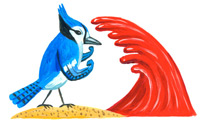
Illustration by Charlie Powell.
No. 8 Creighton Blue Jays vs. No. 9 Alabama Crimson Tide
The Crimson Tide’s logo shows an elephant, but the nickname more commonly refers to a phenomenon in which huge swaths of sea water turn red due to a toxic algal bloom. It’s hard to imagine this happening inside a gymnasium, but supposing it does, the blue jays can easily flit about and avoid inundation. Red tides have killed seabirds in California, but blue jays catch their food in the air, so they should manage to stay dry until the tide recedes. As in the case of the huskies and the cyclone, here we have another lucky animal that survives an imposing physical phenomenon.
No. 5 Temple Owls vs. No. 12 South Florida Bulls
The real thrill is in the play-in game, where the bulls gore the California Golden Bears after an intense tussle. Against the cagey owls, the bulls are forced into a slow-down game. It will take patience, but the feathers will eventually fly.
No. 4 Michigan Wolverines vs. No. 13 Ohio Bobcats
A national-championship-caliber battle between opponents of similar size, both of which punch above their weight class. These feral foes circle warily before tearing into one another with brutal zest, sending fur and blood flying. Bobcats routinely take down fawns, but wolverines—the largest members of the weasel family, weighing as much as a medium-sized dog—can kill adult deer or even, occasionally, elk or moose. There have even been reported cases of wolverines preying on Eurasian lynx, the bobcats’ European cousins. While both sides sustain casualties, the wolverines win a close, crowd-pleasing battle to the death.
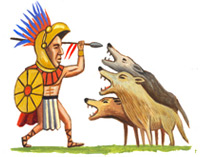
Illustration by Charlie Powell.
No. 6 San Diego State Aztecs vs. No. 11 North Carolina State Wolfpack
Who seeded this tournament? This is another Final Four-level tussle! The Aztecs built one of the proudest civilizations the world had seen, but any five humans would be hard-pressed to fend off a pack of wolves without the assistance of firearms. A few atlatls will hit their mark, but the confines of the arena give the beasts the narrow edge.
No. 3 Georgetown Hoyas vs. No. 14 Belmont Bruins
Hoyas are another mystery. The nickname has its roots in the “Hoya, Hoya Saxa!” chant that’s long been popular among Georgetown students. These days, it simply refers to the school’s athletic teams. Here, then, we have a rare case in which a team based on the school’s nickname could be the same as its actual basketball squad. Otto Porter and Henry Sims are brawny young men, but bruins are bears and are not susceptible to the Princeton offense. The referees in this tournament also do not call mauling fouls.
No. 7 St. Mary’s Gaels vs. No. 10 Purdue Boilermakers
Boilermakers are industrial craftsmen who wear fireproof suits and wield oxyacetylene torches capable of welding plates of metal. The tournament’s second set of Gaels will fare no better than the first.
No. 2 Kansas Jayhawks vs. No. 15 Detroit Titans
Jayhawks are not real birds. The nickname comes from the Jayhawkers, a ragtag pre-Civil War group of Kansas militiamen described by the New York Times as “both zealous abolitionists and violent thieves.” The university’s own website, however, insists the team’s name now refers to an imaginary hybrid of a blue jay and a sparrow hawk, so we’ll have to go with that. Both birds have rather nasty dispositions, though neither is all that large. The Titans, meanwhile, are powerful mythological gods who ruled the earth before being deposed by the Olympians. They include Uranus, god of the sky; Oceanus, an endless river encircling the world; and Cronus, who ate each of his children after they were born. I can see the Titans going far in this tournament.
